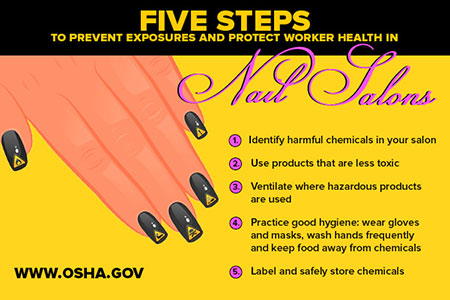Ed. note: This blog is cross-posted from the U.S. Department of Labor Blog. The original post date was January 27, 2015.
 I came to the United States from Vietnam in 1992. After learning about the nail salon industry from friends in my English class, I became a manicurist. The work offered a flexible schedule for mothers of small children, like me, and the required training wasn't as long as for other professions. With determination, I was able to work my way up to eventually becoming the co-owner of Traci's Nails in Oakland, California in 1995. And last year, my business was officially recognized as a "Healthy Nail Salon" by Alameda County, CA for using safer practices and products in my salon. I've been able to do what is best for my health, the health of my co-workers, and my customers.
I came to the United States from Vietnam in 1992. After learning about the nail salon industry from friends in my English class, I became a manicurist. The work offered a flexible schedule for mothers of small children, like me, and the required training wasn't as long as for other professions. With determination, I was able to work my way up to eventually becoming the co-owner of Traci's Nails in Oakland, California in 1995. And last year, my business was officially recognized as a "Healthy Nail Salon" by Alameda County, CA for using safer practices and products in my salon. I've been able to do what is best for my health, the health of my co-workers, and my customers.
Like many other women in my industry, I chose to become a manicurist to make women feel beautiful and to provide for my family. Although there are many good things about the job — the glamour, the artistry, the beautiful colors and new designs — there are also significant hazards. Salon workers are exposed to toxic chemicals and repetitive motions that can cause injuries and illnesses. Many experience health symptoms like difficulty breathing, red and watery eyes, and skin reactions on a daily basis. We tell ourselves to accept these short-term health problems, but worry about possible long-term effects of the chemical exposures like cancer, reproductive issues, and asthma.
The Occupational Safety and Health Administration has many useful resources for salon workers and owners like me, including a booklet called Stay Healthy and Safe While Giving Manicures and Pedicures (Vietnamese, Korean, Spanish). For the last several years, they have been working to empower nonprofit organizations that offer safety training and resources to salon workers and employers through the Susan Harwood Training Grant Program. OSHA also has special webpages about safety in hair and nail salons, dangers of chemicals like toluene, and transitioning to safer chemicals in the workplace. In California, thanks to the work of the California Healthy Nail Salon Collaborative, several counties and cities have implemented Healthy Nail Salon Recognition Programs, recognizing salons that use less toxic products, improve ventilation, and participate in trainings that encourage healthier workplaces.
As an owner, I have gained greater control over the products and practices used in my workplace. I am hoping that other owners in the industry also adopt safer products and practices. That's why the collaborative work of OSHA, advocacy organizations like the California Healthy Nail Salon Collaborative, and local governments is so vital to the lives of salon workers across the country. Nail salon workers and owners should not have to forego good health in order to make a living!
Chanh Hang is a nail salon owner and member of the California Healthy Nail Salon Collaborative.

